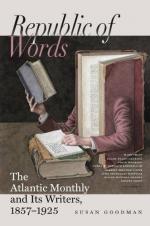Ideal form was to the Greeks the highest result, the success of the universe. The end of Art was conceived as Nature’s end as well, whether actually attained or not. Nor was this preference of certain forms arbitrary, but it followed the plain indications written on every particle of matter. What we call brute matter is whatever is means only, not showing any individuality, or end within itself. A handful of earth is definable only by its chemical or physical properties, which do not distinguish it, but confound it with other things. By itself it is only so much phosphate or silicate, and can come to be something only in a foreign organism, a plant or an animal. In form is seen the dawning of individuality, and just as the thing rises in the scale the principle of form becomes dominant. The handful of earth is sufficiently described by the chemist’s formula,—these ingredients make this substance. But an organic body cannot be so described. The chemist’s account of sugar, for instance, is C^{6} H^{10} O^{5}. But if we ask what starch is, we have, again, C^{6} H^{10} O^{5},—and the cellular tissue of plants, also, is the same. These things, then, as far as he knows, are identical. Evidently, he is beyond his depth, and the higher we go in the scale the less he has to say to the purpose,—the separate importance of the material ingredients constantly decreasing, and the importance of their definite connection increasing, as the reference to an individual centre predominates over helpless gravitation. First, aggregation about a centre, as in the crystal,—then, arrangement of the parts, as upper, under, and lateral, as in the plant,—then, organization of these into members. Form is the self-assertion of the thing as no longer means only; this makes its attractiveness to the artist. The root of his delight in ideal form is that it promises some finality amid the endless maze of matter. But this higher completeness, which is beauty, whether it happen to exist or not, is never the immediate aim of Nature. It is everywhere




